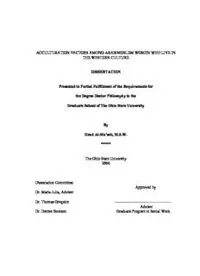
ACCULTURATION FACTORS AMONG ARAB/MOSLEM WOMEN WHO LIVE IN THE WESTERN ... PDF
Preview ACCULTURATION FACTORS AMONG ARAB/MOSLEM WOMEN WHO LIVE IN THE WESTERN ...
ACCULTURATION FACTORS AMONG ARAB/MOSLEM WOMEN WHO LIVE IN THE WESTERN CULTURE DISSERTATION Presented in Partial Fulfillment of the Requirements for the Degree Doctor Philosophy in the Graduate School of The Ohio State University By Hend Al-Ma’seb, M.S.W. ***** The Ohio State University 2006 Dissertation Committee: Approved by Dr. Maria Julia, Adviser Dr. Thomas Gregoire ------------------------------------------- Adviser Dr. Denise Bronson Graduate Program in Social Work ABSTRACT The purpose of this study was to explore the cultural changes experienced by Arab/Moslem women residing in Columbus, Ohio, during the Winter of 2006 based on the six indicators of religion, relationships with non-relative men, living alone, control over decisions, drinking alcohol, and smoking cigarettes. This study also intended to discover the predictive relationship between the period of time that Arab/Moslem women stay in the USA, contact with American culture and people, contact with Arab culture and people, educational level, and acculturation. One hundred and two Arab/Moslem women were recruited through the Islamic organization in Columbus, Ohio. Non-probability data collection method (convenience sampling) was utilized. The participants responded to a questionnaire developed by the researcher. Descriptive statistics were used to answer the first research question (To what extent do Arab/Moslem women who live in Columbus, Ohio acculturate). Multiple regression analysis was conducted to answer the second research question (Can a model consisting of a linear combination of the period of time that Arab/Moslem women stay in the USA, contact with American culture and people, contact with Arab culture and people, and educational level predict the level of acculturation of the Arab/Moslem women living in Columbus, Ohio?). ii The results of the descriptive analysis showed that the Arab/Moslem women who live in Columbus, Ohio were not acculturated to the American culture. The results revealed a statistically significant relationship between the dependent variable of acculturation and three of the independent variables (the period of time that Arab/Moslem women stay in the USA, contact with American culture and people, contact with Arab culture and people). However, the relationship between the dependent variable of acculturation and the independent variable of educational level was not statistically significant. iii Dedicated to my whole family iv ACKNOWLEDGMENTS I would like to express my sincere gratitude and appreciation to the many people who have influenced, supported, and assisted me in the completion of this dissertation, especially to the members of my dissertation committee, Dr. Maria Julia, Dr. Thomas Gregoire, and Dr. Denise Bronson. I am deeply indebted to my advisor, Dr. Maria Julia, for her conscientious attention to my work as it progressed, and for her invaluable input in focusing the direction of my study and clarifying its issues. I would like to thank Dr. Thomas Gregoire for his support, guidance, and helpful thoughts. I am also grateful to Dr. Denise Bronson for her encouragement, support, and critical reading of the various drafts of my study. I am indebted to the Arab/Moslem women in Columbus, Ohio, who were so generous in participating in my study. Without their input, I would not have had a dissertation to write. I would like to thank the Islamic organization leaders for their cooperation and help. I also would like to thank my cohort, especially Wonik lee and David Kondrat for their encouragement and support. Finally, my thanks go to my mother and father who supported my wish to do graduate work in the United States and gave me their blessing to do so. I also thank my husband Suhail for his understanding and help as I worked to research and write my dissertation, and our six-year-old son, Mohammed, for being so patient with us while we balanced his needs with my academic goals. v VITA 1998……………………………….…...B.A. Social Work, Kuwait University. 1998-1999……………………………..Social Worker, Farwaniya School, Kuwait. 2002…………………………………....M.S.W. The Ohio State University FIELDS OF STUDY Major Field: Social Work ix TABLE OF CONTENTS Page Abstract……………………………………………………………………………ii Dedication…………………………………………………………………………iv Acknowledgments………………………………………………………………....v Vita………………………………………………………………………………...vi List of Tables………………………………………………………………………xiv List of Figures……………………………………………………………………..xv Chapters: Introduction………………………………………………………..………………1 1.1 Gender Views of Arab/Moslem Culture...……………….3 1.2 Acculturation Level………………………………………6 1.3 Statement of the Problem………………………………....7 1.4 Research Questions……………………………………....10 1.5 Dependent Variables……………………………………..11 1.6 Significance of the Study to Social Work………………..16 2. Literature Review…………………………………………………………….20 2.1 Defining Culture………………………………………….20 2.2 Acculturation……………………………………………..22 2.3 Assimilation…………………..…………………………..27 2.4 Similarities and differences between acculturation and x assimilation………………………………………………..30 2.4.1 Similarities.…………………………………….….30 2.4.2 Diferences ………………………………………….32 2.5 Acculturation scales……………………………..………...33 2.6 Acculturation and Changes in Immigrants’ Lives………...35 2.7 Social work, Interventions, and Acculturation…………….40 2.8 Factors that Influence the Acculturation process…………..49 2.8.1 Time: the period of time that an emigrant stays in the host culture……………………………………..49 2.8.2 Contact……………………………………………….50 2.8.3 Education…………………………………………….51 2.9 Summary of the Literature Review………………………..52 3. Methodology…………………………………………………………….…….54 3.1 Study Design………………………………………………55 3.2 Setting……………………………………………….…….56 3.3 Sampling Method………………………………...………..58 3.4 Steps in Data Collection..………………………...………..59 3.5 Instrument of the Study……………………………………60 3.6 Validity of the Questionnaire………………………….…..62 xi 3.7 Reliability of the Questionnaire…………………………...63 3.8 Data Analysis……………………………………………...63 4. Data analysis and Results……………………………….……………….…….65 4.1 Treatment of the Data…………………………………...…65 4.2 Descriptive Analysis of the Participants’ Demographic Characteristics………………………………65 4.3 Descriptive analysis of Acculturation……………………...68 4.4 T-Test....................................................................................75 4.5 Multiple Regression Analysis.……………………………..77 4.6 Factor Analysis.....................................................................85 5. Summary and Interpretation of Data……………………………………….….91 5.1 Summary of the Study…………………………………..…85 5.2 Descriptive Analysis of Acculturation…………………..…94 5.3 Multiple Regression Analysis……….…………………..…96 5.4 Implications of the Study ………….…………………..…..98 5.5 Limitations of the Study..………………………..……..….100 5.6 Recommendations for Future Research.……………..…….101 APPENDICES………………………….……………………………….…….103 A. Cover Letter to Arab/Moslem Participants………………….104 B. Cultural Beliefs and Values Questionnaire………………….106 C. The Ohio State University Human Subject xii Approval Form………………………………………….….120 D. Letter of Support From The Islamic Society of Greater Columbus (ISGC)………………………………….122 E. Factor Loading by Item…………………………………….124 REFERENCES...…………………….……………………………….……….127 xiii
